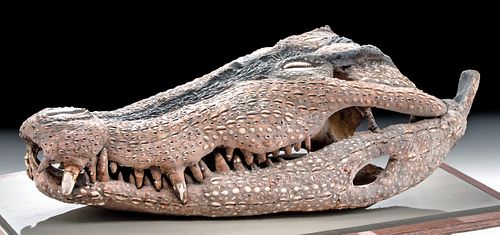Early 20th C. Iatmul Overmodeled Crocodile Skull, Shell
Lot 132a
About Seller
Artemis Fine Arts
686 S Taylor Ave, Ste 106
Louisville, CO 80027
United States
Selling antiquities, ancient and ethnographic art online since 1993, Artemis Gallery specializes in Classical Antiquities (Egyptian, Greek, Roman, Near Eastern), Asian, Pre-Columbian, African / Tribal / Oceanographic art. Our extensive inventory includes pottery, stone, metal, wood, glass and textil...Read more
Categories
Estimate:
$3,000 - $4,500
Absentee vs Live bid
Two ways to bid:
- Leave a max absentee bid and the platform will bid on your behalf up to your maximum bid during the live auction.
- Bid live during the auction and your bids will be submitted real-time to the auctioneer.
Bid Increments
| Price | Bid Increment |
|---|---|
| $0 | $25 |
| $300 | $50 |
| $1,000 | $100 |
| $2,000 | $250 |
| $5,000 | $500 |
| $10,000 | $1,000 |
| $20,000 | $2,500 |
| $50,000 | $5,000 |
| $100,000 | $10,000 |
| $200,000 | $20,000 |
About Auction
By Artemis Fine Arts
Feb 13, 2020
Set Reminder
2020-02-13 10:00:00
2020-02-13 10:00:00
America/New_York
Bidsquare
Bidsquare : Exceptional Antiquities, Asian, Ethnographic
https://www.bidsquare.com/auctions/artemis-gallery/exceptional-antiquities-asian-ethnographic-4848
An important one-day auction featuring museum-worthy examples of Egyptian, Greek, Roman, Etruscan, Near Eastern, Far East / Asian, Pre-Columbian, African / Tribal, Oceanic, Native American, Spanish Colonial, Russian, Fossils, Ancient Jewelry, Fine Art, so much more! Artemis Fine Arts info@artemisfinearts.com
An important one-day auction featuring museum-worthy examples of Egyptian, Greek, Roman, Etruscan, Near Eastern, Far East / Asian, Pre-Columbian, African / Tribal, Oceanic, Native American, Spanish Colonial, Russian, Fossils, Ancient Jewelry, Fine Art, so much more! Artemis Fine Arts info@artemisfinearts.com
- Lot Description
Oceania, Papua New Guinea, Middle Sepik River, Iatmul peoples, ca. early 20th century CE. A striking, overmodeled crocodile skull, from a member of the species of the New Guinea crocodile (Crocodylus novaeguineae). An artist has covered the surface in pale red clay and inlaid hundreds, if not thousands, of cowrie shells over the vast majority of the head and mandible. The back of the skull has been left undecorated, though it does seem to have been heated at some point in the past. The artist has used clay and some thick textiles, placed on the inside of the skull, to hold the mandible in place. The overmodeling does not disguise the power of the animal, whose massive teeth hang over the decorated lips. Size: 30" L x 12" W x 9" H (76.2 cm x 30.5 cm x 22.9 cm); the skull comes with a large plexiglass case which is: 34.5" L x 18.5" W x 16.5" H (87.6 cm x 47 cm x 41.9 cm)
The overmodeled style of skull decoration is a nearly unique feature of this region, relating to the tradition of veneration of human ancestor skulls, which were also overmodeled and kept displayed in the Haus Tambaran, an ancestor worship house located in each local community and distinguished by its steeply pointed roof. This skull would have been kept in one as well, perhaps representing an animal that its inhabitants identified as a guiding spirit of their family group.
Provenance: private Newport Beach, California, USA collection; ex-Gene Johnson collection, San Diego, California, USA; ex-Pacific Gallery collection, Santa Fe, New Mexico, USA, acquired from Papua New Guinea in the late 1900s
All items legal to buy/sell under U.S. Statute covering cultural patrimony Code 2600, CHAPTER 14, and are guaranteed to be as described or your money back.
A Certificate of Authenticity will accompany all winning bids.
We ship worldwide and handle all shipping in-house for your convenience.
#152643Skull has some burn marks near its back end which were probably part of the firing of the clay. One side of the back has a loss from the upper part of the skull, but overall the animal is in very nice condition. Skull, as described above, is held in position with the mandible using clay and textile. A few of the shells are lost but most are in position.Condition
- Shipping Info
-
All shipping is handled in-house for your convenience. Your invoice from Artemis Gallery will include shipping calculation instructions. If in doubt, please inquire BEFORE bidding for estimated shipping costs for individual items.
-
- Buyer's Premium



 EUR
EUR CAD
CAD AUD
AUD GBP
GBP MXN
MXN HKD
HKD CNY
CNY MYR
MYR SEK
SEK SGD
SGD CHF
CHF THB
THB















